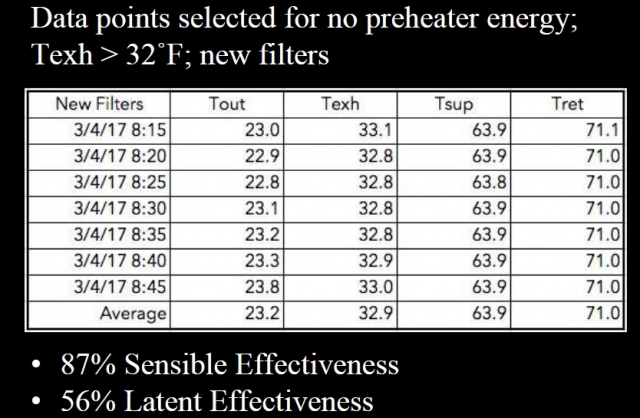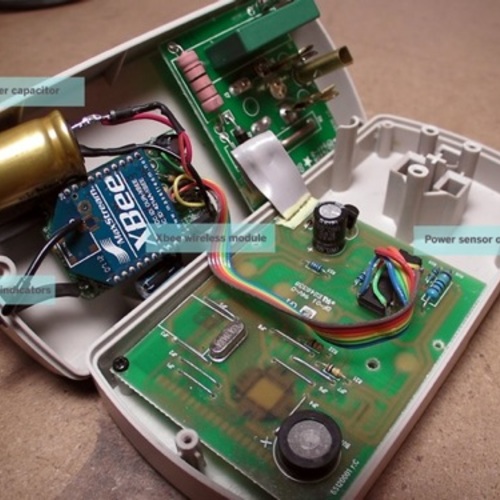
Image Credit: Martin Holladay
At a recent conference in Burlington, Vermont, energy consultant Marc Rosenbaum shared insights that he’s gleaned from several energy monitoring projects. His presentation on February 7, 2018, was part of Better Buildings By Design, a conference sponsored by Efficiency Vermont.
Rosenbaum believes that energy retrofit specialists should regularly measure energy use. “We’re practitioners,” Rosenbaum told the Burlington audience. “Most of the time we try to get it right, and when we don’t we want to know why. So we grind through it. We try it again and test it.”
Weekly Newsletter
Get building science and energy efficiency advice, plus special offers, in your inbox.
Monitoring a Zehnder ERV
At his house on Martha’s Vineyard in Massachusetts, Rosenbaum has a Zehnder ComfoAir 200 energy-recovery ventilator (ERV). Rosenbaum praised Zehnder’s plastic ductwork (so-called ComfoTube ducts). “I cannot find a detectable leak in the ducts,” he said.
He took temperature measurements and power draw measurements to determine the ERV’s effectiveness. “I am interested in effectiveness, not efficiency,” he said. “Most people talk about efficiency. Efficiency measurements include motor watts. Effectiveness is the measure of how much of the temperature differential between outdoor and indoor air is recovered by the ventilator. Effectiveness is affected by motor heat, heat transfer through the case, and internal condensation. You can raise effectiveness by bad design — you can heat the air with the heat from the motor and the fan.”
Summing up, Rosenbaum said, “I’m interested in in the thermal performance of the ERV — the temperature rise as the outdoor air passes through the unit.”

According to Rosenbaum’s measurements,…

This article is only available to GBA Prime Members
Sign up for a free trial and get instant access to this article as well as GBA’s complete library of premium articles and construction details.
Start Free TrialAlready a member? Log in















18 Comments
How is the cfm being measured on the mini-splits?
Measuring air flow through a ductless head without the measuring methods affecting the flow seems like a tough problem to do well in-situ. (It's hard to do accurately even in a lab.) How was that done?
Marc's mini-split is ducted
Small correction to add, Martin - Marc's Fujitsu mini-split at his own house is a ducted system (Fujitsu slim-duct AOU/ARU9).
Thanks for the article...Marc's data is always great to see and learn from. We learn at least 10x more from monitoring houses than we do from modeling them!
HRV Efficiency
"Most people talk about efficiency. Efficiency measurements include motor watts."
I was under the understanding that the equation for Sensible Recovery Efficiency removed the motor watts, to give a picture of the efficiency of strictly the core. The formula for SRE is attached in the picture.
Create An Energy Use Profile
This is good information, with metered electricity and gas much can be learned. I suggest for any energy related building project on existing housing, make an energy use profile. Pull 12 months of electricity and gas bills and determine current usage for heating, cooling and other domestic usage. I also will do a blower door test to start the project so projections can be made on retrofit methods and projected energy saved. In my ice dam remediation project this winter we have started this way and it really helps homeowners to see where their energy dollars are going. Addressing poorly insulated and leaky cathedral ceilings with to code R-values and airtight construction are smart building upgrade decisions. We will drastically lower heating and cooling bills, eliminate the cause of ice dam formation with inner peace for homeowner and builder following.
Do Mitsubishi multi-split head units actually ramp up and down?
The documentation for the Mitsubishi multi-split units seems to indicate that they don't ramp up and down the interior heads individually. The central unit clearly ramps up and down, but it seems that's more a factor of what interior units are on or off rather than the actual aggregate demand.
The measures above seem to support that in that the lack of individual head ramping shows up in the data much more with fewer heads and in a system with a larger number of interior heads.
The documentation I've seen on the Fujitsu multi-splits seems to indicate that they do have some degree ramping for their interior units. However, the specific behavior is not entirely clear.
I've tried to get a definitive answer and understanding of the behavior of these systems, but I've been pretty unsuccessful thus far, despite making a few calls to the Mitsubishi.
Good comments
Martin's on vacation, but I'm sure he will appreciate and respond to the comments when he returns.
Yes, Mitsubishi heads DO ramp up and down @ Christopher Welles
There is a minimum & maximum output for each head, but they modulate to track the sensed load base on the difference between the sensed air temperature & setpoint, and how rapidly the temperature is changing. Even if one programs the head for a fixed blower speed using the remote (or wall thermostat control), it will still adjust the refrigerant volumes to match load within the range that it can.
Mitsubishi isn't inclined to tip their hand and explain their control algorithms in detail, even to the trained technicians, let alone some random guy on the phone (or to Marc Rosenbaum.)
While the power draw graph
While the power draw graph doesn't show the mostly flat power modulation I would expect from a good control algorithm, it doesn't show on/off (0 and 6KW) behavior either. Appears to be too much gain causing too fast ramp up.
It may be that the only variables one has to play with are the thermostat locations/mounting and the "Indoor unit operating average/Set by indoor unit’s remote controller/Remote controller’s internal sensor" setting. A more responsive location for the thermostat should help.
The oscillating power draw isn't good for efficiency.
The Mitsubishi submitals give no range for multi-split heads
Part of what leads me to doubt the ability to ramp up and down is that the submittals only give single numbers for capacity instead of the range numbers they do for the same unit when used in a mini-split configuration. The outdoor units give capacity numbers for the indoor heads when using various mixes of indoor units.
For example, the system described in the article seems to be a MXZ-8C48NAHZ with a 12 + 18 + 30 head configuration. The submittal shows a heating capacity of (10,700), (16,000), and (27,300) btu for each head respectively. (see pages 8 of: http://meus1.mylinkdrive.com/files/MXZ-8C48NAHZ_Submittal.pdf ) It doesn't give you any idea of how far down it would be able to modulate.
When I look at the submittals for a 12K interior head, I see they have one version with a "Capacity Range" for the unit in a mini-split configuration: http://meus1.mylinkdrive.com/files/MSZ-FH12NA~MUZ-FH12NA_Submittal.pdf
And a different submittal for the same unit in a multi-split configuration, but no range specified: http://meus1.mylinkdrive.com/files/MSZ-FH12NA_For_MXZ_MULTI-ZONE_SYSTEMS_ProductDataSheet.pdf
I can see why expressing that information might be challenging for a multi-split configuration, but I can also see why ramping up and down interior units would be much more complicated with a multi-split than a mini-split.
The whole reason I've chased this thing is that I want to be able to support some small zones. I can't install something and then find that it won't function as anticipated. It can be done with individual mini-splits, but the idea of having 5 mini-split outdoor units seems rather ridiculous, and probably too expensive. Hydronic cooling isn't any less ridiculous or expensive though.
multi-split indoor unit modulation?
Similar for Fujitsu - no mention of a range.
http://www.fujitsu-general.com/us/resources/pdf/support/downloads/submittal-sheets/ARU9RLF.pdf
This source writes "However, multi-split systems turn OFF or ON completely in response to one master controller, whereas VRF systems continually adjust the flow of refrigerant to each indoor evaporator.".
http://www.seedengr.com/Variable%20Refrigerant%20Flow%20Systems.pdf
I don't consider these prices so bad:
http://www.chiltrix.com/documents/price-list.html
ducted single mini vs. multi mini
This article seems to suggest that a ducted single mini-split *Might Be* better than a multiple head system in some scenarios--even with losses from ducts. Is that a good take away? I had assumed just the opposite.
Ducted mini-splits CAN be more efficient. @ Antonio Oliver
Whether modulating or not the "head per room" approaches to multi-splits or mini-splits invariably oversizes the system. A ducted mini-split cassette (modulating or not) better matched to the combined room loads that it's serving will usually be more efficient.
other sources of discomfort and inefficiency
Some over-sizing can increase efficiency with minimal effect on humidity.
I looked at one ducted head and getting proper throw from the registers looked to be almost impossible without exceeding rated static pressure. Would be interesting to see actual measurements relating to this issue. Also regarding how well room-to-room temp balance holds up under varying conditions (ie peak deviation).
> ducted single mini-split *Might Be* better than a multiple head system
I'd say that is likely except in purchase cost.
ducted systems may have less modulation
My understanding is that the ducted units probably don't have the same turn-down as the ductless ones. With a ductless head you have a blower designed for low velocity/high volume for maximum turn-down, whereas the ducted units need to move air at high velocity. My guess is that the controls allow only a limited turn down because the registers just won't throw at low velocity. If so then the ducted units would be more bang-on/bang-off. And if the system is at all oversized, then that will exacerbate things of course.
So maybe this is about the efficiency difference between ducted and ductless, not about single vs multihead.
My recollection is that multi
My recollection is that multi head units are never spec'ed as being as efficient as single and they cost more than buying several single units, so I never personally considered them.
I would think the only place they are appropriate is when outside space is so limited that multiple compressors are impossible.
Response to John Semmelhack
John,
Thanks for your comment. You're right -- Marc Rosenbaum's house on Martha's Vineyard has a single-zone ducted minisplit unit, not a single-zone ductless minisplit unit. I have corrected the text of my article.
At Rosenbaum's previous house on Martha's Vineyard, he had a ductless system in his living room. At his new house, he has a ducted system. Thanks for the correction.
For more information on Marc Rosenbaum's house, see these three GBA articles:
Moving to a New House
Solving Our Design Problems
What We Started With
Ways to modulate
My limited experience actually living with a Fujitsu 12k wall cassette single zone system in one house, then a Fujitsu ducted 9K unit in my current house, is that the ducted unit doesn't modulate air flow nearly so much as the cassette, so the modulation is accomplished with less temperature rise. It's common for me to see slightly below 250W going into the unit. There are some design considerations with this - you don't want to blow 80F air on people!
I thought I understood the difference between ducted mini-split and multi-split but now I'm not sure. Can someone clarify?
I am trying to figure out which to use in my upstairs which is 1240 sf consisting of 2 baths, 1 guest room, 1 exercise room and 1 loft paint studio.
Log in or become a member to post a comment.
Sign up Log in